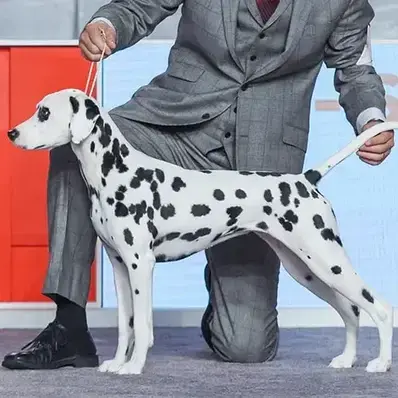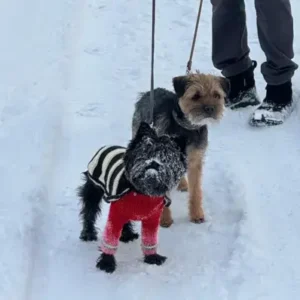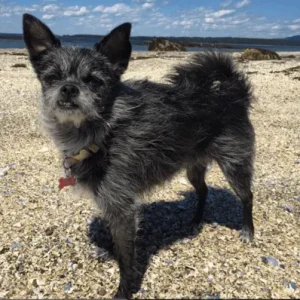Dalmatian History/Origin
The origins of the Dalmatian breed remain shrouded in mystery, though historical records suggest they traveled with nomadic Romanies or gypsies. Their name comes from Dalmatia, a region along the Adriatic Sea (modern-day Croatia), where they served as guard dogs, shepherds, ratters, and circus performers.
In England, they gained fame as coaching dogs, running alongside horse-drawn coaches, and protecting horses and passengers alike.
Dalmatian History- Source: AKC.org
In the United States, their natural affinity for horses led them to serve as firehouse mascots, accompanying firefighters on calls and guarding equipment. Today, while most Dalmatians are beloved family pets, they continue to hold a special place in many firehouses across the country as cherished mascots.
The AKC recognizes the Dalmatian under the Non-Sporting Group.
Dalmatian Personality
The Dalmatian is one of the dog breeds known for its energetic and lively personality, embodying a true zest for life. They are playful and outgoing, often seeking attention and enjoying interactive activities with their owners.
Dalmatians are also highly intelligent, which, coupled with their mischievous sense of humor, makes them delightful companions. They are alert and curious, always eager to explore their surroundings and engage with their environment.
- Temperament
Dalmatians have a friendly and affectionate temperament, bonding closely with their families. They are generally good-natured and love to please their owners, which makes them responsive to positive reinforcement training methods.
- Potential Challenges
While Dalmatians are loving and loyal, their high energy levels can present challenges for owners who are not prepared for their exercise needs. Without sufficient exercise and mental stimulation, they may become bored and exhibit destructive behaviors.
Additionally, their strong prey drive and independent streak can sometimes lead to stubbornness, requiring consistent training and socialization from an early age.
Dalmatian Physical Appearance
The Dalmatian is a medium-sized dog, well-balanced and muscular. These purebred dogs have a distinctively spotted short coat, high-set drop ears, and a natural tail carried with a slight upward curve. Known for their endurance and speed, deviations from these standards should be penalized in direct proportion to the degree of deviation.
- Size
Dalmatians typically stand between 19 to 24 inches tall at the shoulder, making them a medium-sized breed. They generally weigh between 47 to 50 pounds, showcasing a sturdy build that complements their athletic and agile nature.
- Coat color
The Dalmatian’s coat is smooth to the touch, with a short and fine texture. The tops of their heads feel velvety. They have a white base color covered in well-defined black or brown spots of varying sizes, evenly spread across their body. Smaller spots are often found on their legs, head, and tail. Some Dalmatians may also have tan markings on their head, neck, chest, legs, or tail, adding a tricolor pattern to their appearance.
Dalmatian Gender Differences
There’s a slight size difference between genders in Dalmatians, with males tending to be larger than females.
In terms of temperament, female Dalmatians are less assertive and aggressive, and known for their intelligence and cleverness. Male Dalmatians are high-energy and can be aggressive toward other males, though they are playful and eager to please, maturing more slowly than females.
Dalmatian Feed/Nutrition
Adult Dalmatians typically require 1.5 to 2 cups of high-quality dry food per day, split into two meals. How much food they need depends on factors like size, age, metabolism, and activity level, similar to individual dietary needs in humans. Active dogs generally require more food compared to less active ones.
Choosing high-quality dog food ensures your dog receives optimal nutrition, requiring less quantity to satisfy their dietary needs. Adding broccoli as an occasional treat can provide vitamins and fiber, but make sure to serve it in moderation.
Dalmatian Health
Dalmatians are generally healthy dogs, but like all breeds, they have specific health concerns to be aware of. Not all Dalmatians will develop these conditions, but prospective owners should consider them when choosing the breed. When getting a puppy, it’s crucial to find a reputable breeder who provides health clearances for both parents.
- Hereditary deafness: It is a concern in Dalmatians, with around 8% born completely deaf and 22-24% born with hearing in one ear. Ears typically open by 12-16 days old, but deafness can develop due to deterioration of nerve cells in the cochlea. The BAER test is the most reliable for detecting deafness.
- Urolithiasis: Also called urinary bladder stones, is common due to Dalmatians’ unique urinary system that produces uric acid instead of urea. This condition can be fatal if the urinary tract becomes blocked, requiring dietary management and regular urine checks for urate crystals.
- Skin allergies: It affects many Dalmatians, including food-based, contact, and inhalant allergies, often leading to ear infections. Treatment involves eliminating diets, removing allergens, and managing symptoms based on severity.
- Hip dysplasia: It is a hereditary condition, that can cause pain and arthritis in Dalmatians. Screening through X-rays is recommended, and dogs with hip dysplasia should not be bred.
- Iris Sphincter Dysplasia: Though less common, can lead to vision problems and is under ongoing study in Dalmatians. Regular veterinary check-ups are important to monitor and manage these potential health issues.
- Glaucoma: Glaucoma is a condition characterized by increased pressure within the eye, which can lead to optic nerve damage and vision loss. Dalmatians, like other breeds, may be genetically predisposed to primary glaucoma. Symptoms include redness, excessive tearing, and vision changes. Early detection and treatment are crucial to prevent irreversible eye damage.
- Heart Disease: Dalmatians are prone to heart conditions such as dilated cardiomyopathy (DCM) and mitral valve disease. DCM involves the weakening of the heart muscle, leading to reduced pumping efficiency. Mitral valve disease affects the heart valves, causing them to leak and impair blood flow. Regular veterinary check-ups are important to monitor heart health and detect early signs of disease.
- Laryngeal Paralysis: Laryngeal paralysis is a condition where the muscles that control the opening and closing of the larynx do not function properly. This can lead to breathing difficulties, especially during exercise or in hot weather. Surgery may be recommended in severe cases to alleviate symptoms and improve airflow.
Dalmatian Care and Grooming
Dalmatians are clean dogs with minimal odor and dirt-repellent coats. While they enjoy rolling in mud, their coats dry to a gleaming shine. However, they shed year-round. To manage shedding, brush your Dalmatian weekly with a medium-soft rubber curry brush. Limit baths to three or four times a year to avoid drying out their skin.
Brush their teeth two or three times a week to prevent tartar buildup. Trim their nails once or twice a month if they don’t wear down naturally.
Dalmatians are highly energetic and need at least 60 minutes of exercise daily, including walks, runs, or playtime. Mental stimulation, like agility training or puzzle toys, is also important to prevent boredom and destructive behavior.
Regular exercise and engagement are essential for their well-being. Training your dog not to bite excessively is also crucial, as it helps maintain a calm environment and ensures better behavior overall.
Dalmatian Rescue Groups
Rescue groups dedicated to Dalmatians provide vital support by rescuing dogs from shelters or undesirable situations, offering them veterinary care, and finding them loving homes. These organizations often rely on volunteers and donations to operate, focusing on rehabilitation and ensuring each dog receives proper care and attention.
Dalmatian Price
The price of a Dalmatian typically ranges from $450 to $1,200, depending on factors such as breeder reputation, pedigree, and location.
When considering purchasing a Dalmatian, it’s essential to seek reputable breeders who prioritize the health and well-being of their dogs. Responsible breeders provide health clearances for genetic conditions, ensure proper socialization of puppies, and offer ongoing support to new owners.
Interesting Facts
- They have appeared in the animated film “101 Dalmatians,”. You might have noticed that Pongo and Perdita’s 15 puppies are born completely white. Like actual Dalmatians, these fictional pups develop their iconic spots as they mature.
101 Dalmatians- Source: IMDb
- Just as no two people have identical fingerprints, each Dalmatian possesses a unique pattern of spots.
- Ariana Grande has owned Dalmatian.
Ariana Grande with her Dalmatian – Source: Pinterest
Best For
Dalmatians make excellent pets for active individuals or families who can commit to providing them with plenty of exercise and mental stimulation. They thrive in homes where they are included in daily activities and given opportunities to participate in sports or playtime.
Top Names
| Male Dalmatian Names | Female Dalmatian Names |
| Max | Bella |
| Charlie | Daisy |
| Rocky | Lucy |
| Duke | Mia |
| Oliver | Sophie |









 Dalmatian History- Source:
Dalmatian History- Source: 

 White Dalmatian with black spots- Source:
White Dalmatian with black spots- Source:  White Dalmatian with brown spots – Source:
White Dalmatian with brown spots – Source: 
 101 Dalmatians- Source:
101 Dalmatians- Source:  Ariana Grande with her Dalmatian – Source:
Ariana Grande with her Dalmatian – Source: 






